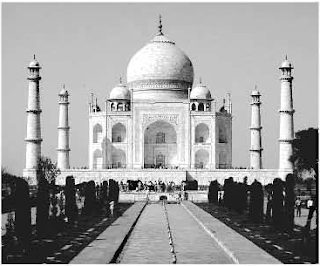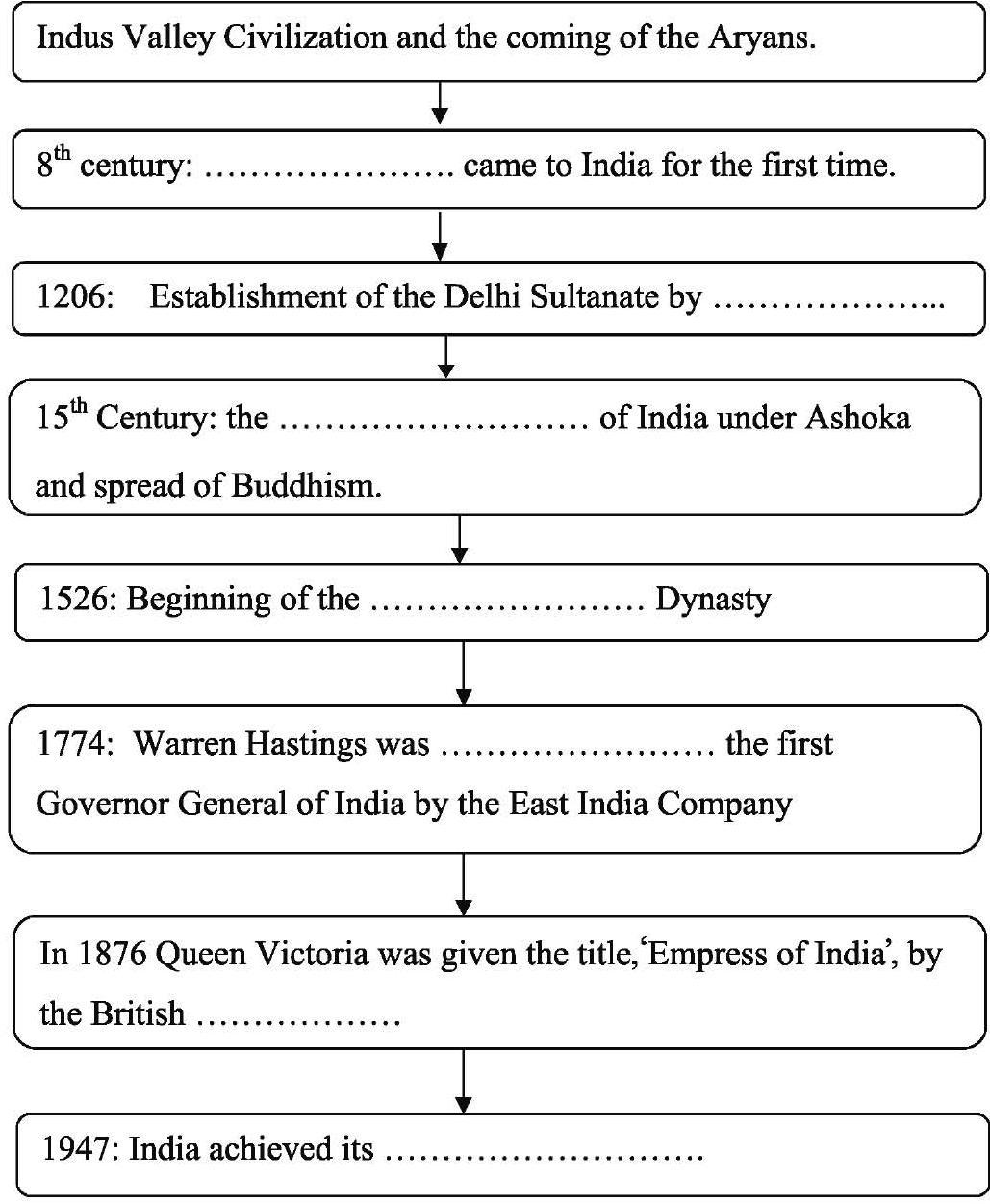A. Read the following text and answer the questions.
India is our closest neighbour. It is the largest among South Asian Countries. In fact, India is the seventh largest country in the world with an area of 3,287,590 square kilometers. India is bounded by the Indian Ocean on the South, the Arabian Sea on the West and the Bay of Bengal on the East. It is bordered by Pakistan to the West; China, Nepal, and Bhutan to the North; and Bangladesh and Myanmar to the East. India is the world's second most populous country after China. Its population is around 1.5 billion. New Delhi is the capital of India and about 13 million people live in the city.
India is a land of ancient civilization. The social, economic and cultural diversity of this vast country is the result of invasions by different races in the process of history. Indian history begins with the birth of the Indus Valley Civilization and the coming of the Aryans. During this period, Aryan culture flourished in this part of the world. The fifth century saw the unification of India under Ashoka, and it is in his time that Buddhism spread in many parts of Asia. In the eighth century, Islam came to India for the first time and by the eleventh century it had firmly established itself. In 1206, Qutbuddin Aybeck founded the Delhi Sultanate. This was finally succeeded by the Mughal Empire in 1526, under which India once again achieved a large measure of political unity.
It was in the 17th century that the Europeans came to India. This coincided with the disintegration of the Mughal Empire, paving the way for supremacy of the English, the French, the Dutch and the Portuguese who were vying with each other to gain control of India. The English emerged as the Victors'. In 1774, Warren Hastings was appointed the first Governor General of India by the East India Company. In 1876, Queen Victoria was given the title 'Empress of India' by the British Parliament and India came under the British rule . The British ruled India for nearly two hundred years. This period was marked by India's struggle for independence. Through a series of heroic and patriotic movements to restore freedom, India got its independence in 1947.
The culture of India is one of the oldest and the most unique in the world. There is amazing cultural diversity throughout the country. The South, North, and Northeast have their own distinct cultures and almost every state has carved out its own cultural distinction. There is hardly any culture in the world that is as varied and unique as India. There are 17 major languages and 844 dialects used by the people of India.
India is a tourists1 delight. The Taj Mahal, Fatehpur Sikri, the Qutb Minar and the Red Fort are a few of the many wonders which attract people from all over the world. Kashmir has been described as a paradise on earth. The country of mountains, valleys, deserts, rivers and lakes offer the richness of a mini jajmahal world within a single country. The Nilgiri mountains, hill stations like Ooty and Darjeeling and the temples of South India, Ajanta and Ellora caves are the places one can explore in India.
B. Discuss the following questions in pairs.
1. What do you know about the population and geographical area of India?
2. When did Buddhism spread in India?
3. What happened to India during the Mughal Empire?
4. What are some of the tourist attractions in India?
C. Complete the flow chart below to show the history of India. Use one word to fill in each gap.
If you want to read the next lesson of this unit please click the link below:
India is our closest neighbour. It is the largest among South Asian Countries. In fact, India is the seventh largest country in the world with an area of 3,287,590 square kilometers. India is bounded by the Indian Ocean on the South, the Arabian Sea on the West and the Bay of Bengal on the East. It is bordered by Pakistan to the West; China, Nepal, and Bhutan to the North; and Bangladesh and Myanmar to the East. India is the world's second most populous country after China. Its population is around 1.5 billion. New Delhi is the capital of India and about 13 million people live in the city.
India is a land of ancient civilization. The social, economic and cultural diversity of this vast country is the result of invasions by different races in the process of history. Indian history begins with the birth of the Indus Valley Civilization and the coming of the Aryans. During this period, Aryan culture flourished in this part of the world. The fifth century saw the unification of India under Ashoka, and it is in his time that Buddhism spread in many parts of Asia. In the eighth century, Islam came to India for the first time and by the eleventh century it had firmly established itself. In 1206, Qutbuddin Aybeck founded the Delhi Sultanate. This was finally succeeded by the Mughal Empire in 1526, under which India once again achieved a large measure of political unity.
It was in the 17th century that the Europeans came to India. This coincided with the disintegration of the Mughal Empire, paving the way for supremacy of the English, the French, the Dutch and the Portuguese who were vying with each other to gain control of India. The English emerged as the Victors'. In 1774, Warren Hastings was appointed the first Governor General of India by the East India Company. In 1876, Queen Victoria was given the title 'Empress of India' by the British Parliament and India came under the British rule . The British ruled India for nearly two hundred years. This period was marked by India's struggle for independence. Through a series of heroic and patriotic movements to restore freedom, India got its independence in 1947.
The culture of India is one of the oldest and the most unique in the world. There is amazing cultural diversity throughout the country. The South, North, and Northeast have their own distinct cultures and almost every state has carved out its own cultural distinction. There is hardly any culture in the world that is as varied and unique as India. There are 17 major languages and 844 dialects used by the people of India.
India is a tourists1 delight. The Taj Mahal, Fatehpur Sikri, the Qutb Minar and the Red Fort are a few of the many wonders which attract people from all over the world. Kashmir has been described as a paradise on earth. The country of mountains, valleys, deserts, rivers and lakes offer the richness of a mini jajmahal world within a single country. The Nilgiri mountains, hill stations like Ooty and Darjeeling and the temples of South India, Ajanta and Ellora caves are the places one can explore in India.
B. Discuss the following questions in pairs.
1. What do you know about the population and geographical area of India?
2. When did Buddhism spread in India?
3. What happened to India during the Mughal Empire?
4. What are some of the tourist attractions in India?
C. Complete the flow chart below to show the history of India. Use one word to fill in each gap.








0 Comments:
Post a Comment